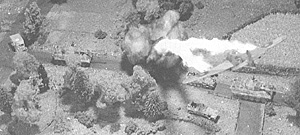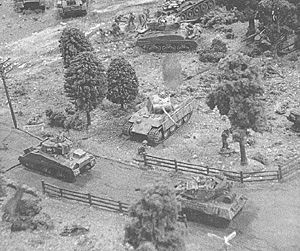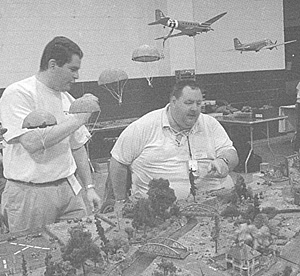 IN THE BEGINNING
IN THE BEGINNING
In November of 2001, Martin Baber and I came up with the insane idea of trying to produce a convention game of Operation Market-Garden in 20 mm scale. All of it- Market and Garden in one game on one table. In November of 2003, we did it- with 11 umpires, 50+ players and 70 feet of hand-sculpted terrain representing the Allied attack corridor from Eindhoven to Oosterbeek. When we first embarked on this project, I flailed around a bit trying to come up with a historically based set of rules. The result was a clumsy limping beast of a system that was neither playable nor fun. I quickly put this wounded animal out of its misery and started over.
So, where to start? Start with the fun. Our most important objective throughout this insane project was to come up with a wargaming experience that will be fun for both the players and the umpires. I also factored in the fact that the players would need to be able to learn the rules quickly, that the rules had to be able to hold together the action happening on over 50 feet of terrain, and that the rules had to hold peoples' interest for the entire day and a half that the game was going to run. In the end I settled on what I like to think of as an impressionistic set of rules. I threw out the idea of ground scale and time scale- I didn't worry about the subtle technical differences between different weapon systems- I kept forcing myself to simplify, simplify, simplify. The result looks simple and abstract up close, but gives the feel of a fast, desperate battle when played.
EASY TO LEARN
We knew we needed a system that was going to immerse the player in the game within the first 10 minutes of play. We had spent so much time on the terrain and figures that we wanted that miniature world to come to life as quickly as possible. So, we needed a simple turn structure and fast combat resolution. I worked off the basic move, move, fire framework because everyone is familiar with it. We weren't using any time scale or ground scale so weapons are dealt with by their relative combat power- a machine gun is relatively more powerful than a rifle, and less powerful than a cannon, etc.
It all boiled down to how many dice do you throw- Bigger boom? More dice. Again, familiar concepts. There are only a few modifiers, but they are carefully chosen to reward good tactics. The weapon ranges were intentionally kept short, because we wanted the combat to fit the battlefield. The longest range weapons can shoot 36" with direct fire. In each of our play-testing sessions, novice players were able to grasp the rules by about the third turn.
HOLDING IT ALL TOGETHER
How do you coordinate the action over 50 feet of wargaming terrain? You don't. And it works. On a table this size, the action will naturally devolve into a number of separate but linked battles. By positioning an umpire at each of these battles, we can let each run at its own pace. The turn structure is so simple that when two skirmishes spill over into each other, it is very easy to synch up the action. There are a number of benefits to using this method. Players develop tunnel vision on their sector and lose track of how the battle is progressing in other areas. Hey, presto! Fog of war! As battles run together, players are forced to react to fire and artillery coming at them at unpredictable times. So watch your flanks!
 KEEPING THE INTEREST
KEEPING THE INTEREST
What is the key to holding the player's interest for hours on end? Speed. No, not amphetamines, fast game play. The game has to MOVE! How fast? In one recent play-test we got through 35 turns in 3 and a half hours- an average of 6 minutes a turn. The most important (and exhausting) job that the umpires have is keeping up the pace of play. If the game slows down, it's like watching a movie frame by frame. When the pace is quick, players stop paying attention to the tiny actions that happen within the turn, and start getting engrossed in the action that is occurring over multiple turns. In other words, the story of the battle is able to take center stage. Playing aids have an important role in keeping things quick. Players will have a 5x8 card that will have all the rules they need to play the game. They will also have a number of 3x5 unit cards held in a sheet protector that give the combat factors for the figures under their command. These cards minimize clutter and make combat resolution quick and easy. With these aids, a dice box and a ruler, the players are ready to go.
We've worked out a number of special systems to deal with things that we thought might be bottlenecks in the game. One of the most important was house-to-house fighting. The terrain encompasses 3 major built up areas and 11 villages. We knew that a clunky system for fighting in buildings could kill the game. Marty came up with the miracle answer: UNO. You know, that children's card game where you have to follow either the number or suit of the card played before you? That game is God's answer to gaming urban warfare.
Here's what you do; give the defenders of a house as many playing cards as there are figures in the building. Give the attackers as many cards as they have people storming the building. The defenders play the first card, and the attackers must play a card that is either the name number or same suit as the defender's card. The player who plays the last card wins the combats and takes or keeps control of the building. Face cards cause one casualty and aces cause two. That's it. Try it! You'll be amazed!
 HOW IT PLAYS
HOW IT PLAYS
You might be saying, "But all you've done is come up with a set of skirmish rules." And you'd be right. "But Market-Garden was a huge operation involving multiple divisions and whole army groups!" If you want to play an operational level game, buy a map and some flags on pins. You don't build 50 feet of sculpted terrain to futz around with chain of command and logistics schedules. You make that terrain to play on. And when you get it all together, and the turns are flashing by, and your small command is desperately assaulting a farm while as far as you can see to either side of you other small commands are fighting their own savage skirmishes, it feels like a big battle. The fact that it's moving so fast, that you can't keep track of it all, and that it just keeps going all work together to create the impression that you are a front line commander who is part of a large operation. It all comes back to fun. Play complex games at home or with your local club. At a big show, play a game that is simple, fast and fun. You won't be sorry you did.
Operation Market-Garden MegaGame Rules
Back to MWAN # 128 Table of Contents
Back to MWAN List of Issues
Back to MagWeb Magazine List
© Copyright 2004 Hal Thinglum
This article appears in MagWeb.com (Magazine Web) on the Internet World Wide Web.
Other articles from military history and related magazines are available at http://www.magweb.com